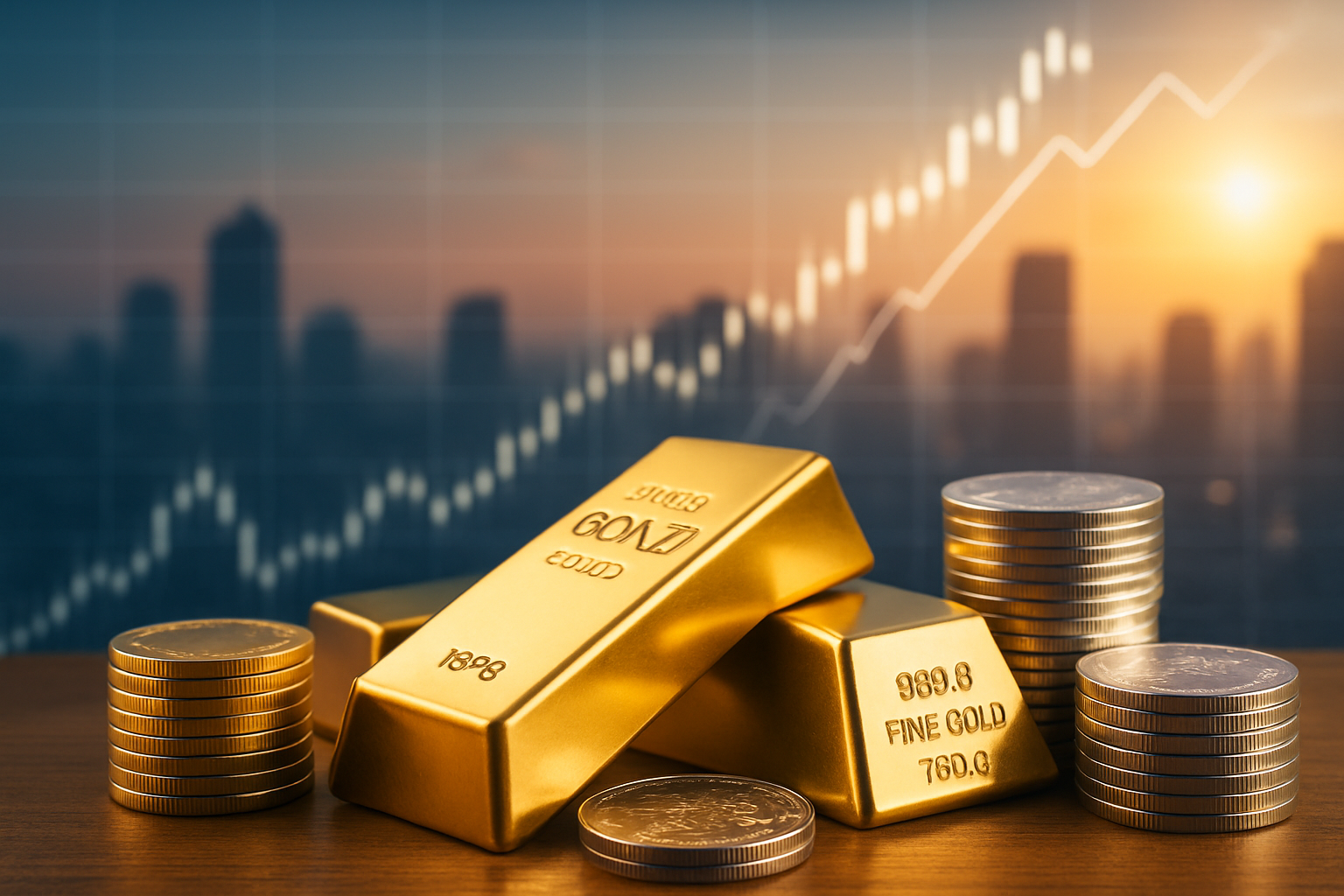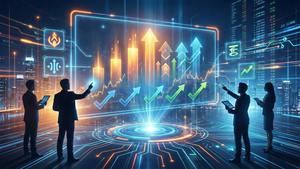Gold and Silver Soar to Unprecedented Highs: Is the Bull Run Sustainable?

The global financial markets are currently witnessing a historic and robust bullish run for both gold and silver, with both precious metals reaching unprecedented highs in the period leading up to October 2025. This significant surge, driven by a complex interplay of macroeconomic shifts, escalating geopolitical tensions, and evolving supply-demand dynamics, has sent ripples across investor sentiment and prompted a widespread re-evaluation of portfolio strategies. As gold breaches the $4,300 per ounce mark and silver surpasses $54, the burning question for investors and analysts alike is whether this remarkable ascent is sustainable, and what the long-term outlook holds for these traditional safe-haven assets.
A Golden and Silver Surge: Unpacking the Historic Rally
The past year has been nothing short of extraordinary for precious metals. Gold, the perennial safe-haven, embarked on an impressive climb throughout 2024, setting 40 new all-time highs and peaking around US$2,778 per ounce by late October of that year. The momentum continued unabated into 2025, with gold shattering the US$3,000 barrier for the first time in history by March, and astonishingly breaking the $4,000 per ounce threshold in the third quarter. As of October 17, 2025, spot gold prices have surged past $4,300 per ounce, with COMEX gold futures nearing $4,289.90, marking year-to-date gains exceeding 60%.
Silver, often referred to as "poor man's gold" but with significant industrial utility, has mirrored this bullish trend with even greater volatility and impressive gains. After breaking a decade-long ceiling in 2024 by surpassing $30 per ounce and rallying 40% to reach $35, it settled around $32 by mid-December. The metal experienced a decisive momentum shift at the beginning of 2025, crossing the US$30 barrier in early January and climbing to US$34.21 by late March. By October 2025, silver had soared above $51 per ounce, emphatically breaking the $54 per ounce barrier on October 17, 2025, reaching an all-time high of US$54.16 just the day prior. Year-to-date gains for silver have exceeded 80%, showcasing its dual appeal as both a precious and industrial metal.
Several key drivers have converged to fuel this unprecedented rally. Expectations of interest rate cuts by central banks, particularly the Federal Reserve, and a broader trend towards lower real interest rates, have significantly reduced the opportunity cost of holding non-yielding assets like gold and silver. Persistent global inflation and concerns over currency debasement, amplified by trillions in new debt and ongoing fiscal expansion, have reinforced the traditional role of precious metals as hedges against economic uncertainty. Central banks worldwide have been diversifying their reserves by accumulating gold at a historic pace, with data through mid-2025 showing multi-decade highs in gold buying, further cementing gold's value as a long-term store of wealth. Moreover, rising geopolitical tensions, renewed trade conflicts, and military flashpoints have driven a significant "flight to safety" towards these reliable assets. A weaker US dollar has also made dollar-denominated gold and silver more affordable for international buyers, boosting demand. For silver, robust industrial demand, particularly from the green energy transition (solar panels, electric vehicles) and electronics, coupled with declining total silver supply over the past decade, has created structural demand deficits, exacerbating price increases. The immediate market reaction has been a profound shift towards "risk-off" sentiment, with investors globally re-evaluating portfolios and increasing allocations to precious metals for diversification and wealth preservation.
Miners and Manufacturers: Who Wins and Who Loses?
The sustained surge in gold and silver prices has created a clear delineation of winners and losers within the financial ecosystem, with precious metals mining companies standing out as primary beneficiaries. Companies like Barrick Gold (NYSE: GOLD), Newmont Corporation (NYSE: NEM), and Agnico Eagle Mines Limited (NYSE: AEM) in the gold sector, alongside Wheaton Precious Metals Corp. (NYSE: WPM), Pan American Silver Corp. (NASDAQ: PAAS), and First Majestic Silver Corp. (NYSE: AG) in the silver space, are experiencing significantly enhanced profitability and cash flows. With relatively fixed production costs, the soaring selling prices directly translate into wider profit margins and robust balance sheets. This allows for increased capital expenditures, debt reduction, and potentially higher shareholder returns through dividends or buybacks. Investors seeking leveraged exposure to precious metals prices often turn to these mining stocks, which tend to outperform the metals themselves during strong bull markets.
Beyond direct miners, companies involved in precious metals streaming and royalty agreements, such as Franco-Nevada Corporation (NYSE: FNV) and Wheaton Precious Metals Corp., also stand to gain immensely. Their business model provides them with a percentage of future production or revenue from mining operations, meaning their income streams directly benefit from rising commodity prices without the operational risks associated with mining. Furthermore, providers of precious metals ETFs, like SPDR Gold Shares (NYSEARCA: GLD) and iShares Silver Trust (NYSEARCA: SLV), see increased inflows, leading to higher assets under management and corresponding fee revenues. Bullion dealers and refiners also benefit from increased demand for physical gold and silver.
However, not all entities thrive in this environment. Industries heavily reliant on silver as an industrial input, such as certain electronics manufacturers, solar panel producers, and automotive companies utilizing silver in electric vehicles, could face increased production costs. While demand for these products remains strong, the elevated price of silver could squeeze profit margins if they cannot pass on the increased costs to consumers. Companies with significant short positions in gold or silver, or those holding large unhedged inventories of other commodities that typically underperform during "risk-off" periods, would also face losses. Furthermore, a prolonged surge in precious metals, often indicative of broader economic uncertainty or inflation, could negatively impact sectors sensitive to consumer spending or interest rates, creating a challenging environment for a diverse range of public companies outside the precious metals sphere.
Wider Implications: A Paradigm Shift in Global Finance
The sustained bullish run in gold and silver is more than just a commodity price spike; it signifies a potentially profound paradigm shift in global finance and investment philosophy. This event fits squarely into broader industry trends emphasizing wealth preservation and diversification amidst an increasingly unpredictable global landscape. The role of precious metals as a hedge against inflation and currency debasement has been unequivocally reinforced, challenging the long-held dominance of traditional fiat currencies and government bonds as primary safe havens. This trend is further exacerbated by unprecedented global debt levels and ongoing quantitative easing measures by central banks, which contribute to a long-term erosion of purchasing power.
The ripple effects extend far beyond the immediate precious metals market. Competitors in the alternative asset space, such as certain cryptocurrencies that market themselves as "digital gold," may find their narrative challenged by the tangible and historically proven stability of physical gold and silver. Partners in the industrial sector, particularly those involved in renewable energy and electronics, face the dual challenge and opportunity of rising silver prices. While higher input costs are a concern, the sustained demand for silver in these critical green technologies underscores its indispensable role in future economic growth, potentially driving innovation in material efficiency or recycling.
Regulatory and policy implications are also significant. Governments and central banks, faced with the implications of persistent inflation and a flight to tangible assets, may be compelled to re-evaluate their monetary policies, fiscal spending, and reserve management strategies. The increasing central bank gold buying trend signals a strategic diversification away from traditional reserve currencies, potentially leading to a more multipolar global financial system. Historically, periods of significant precious metals rallies have often coincided with economic instability, high inflation, or geopolitical upheaval. The 1970s, for instance, saw gold surge amidst stagflation and geopolitical tensions, while the post-2008 financial crisis period also witnessed a notable rally. These historical precedents suggest that the current rally is not an isolated event but rather a response to deep-seated systemic pressures, indicating a potential long-term re-rating of precious metals in global asset allocation strategies.
What Comes Next: Navigating the Precious Metals Landscape
Looking ahead, the short-term and long-term possibilities for gold and silver are shaped by the very factors that have propelled their recent ascent. In the short term, continued geopolitical instability, sustained inflationary pressures, and any further dovish shifts in central bank monetary policy are likely to provide ongoing support for precious metals. However, the market should also anticipate periods of consolidation or even sharp pullbacks, which are healthy corrections in any strong bull market. These dips could present strategic buying opportunities for investors looking to establish or increase their positions. The market will be closely watching inflation data, central bank communications, and geopolitical developments for cues.
For the long term, the outlook for precious metals appears robust. Structural drivers, including persistent global debt levels, ongoing central bank diversification away from traditional reserve currencies, and continued geopolitical fragmentation, are expected to underpin a sustained bull market. Silver, with its dual role as a precious and industrial metal, stands to benefit significantly from the accelerating global transition to green energy, which will continue to drive industrial demand. This fundamental demand, coupled with potential supply constraints, suggests a favorable long-term trajectory for silver.
Potential strategic pivots for investors include maintaining a diversified portfolio with a prudent allocation to precious metals, considering both physical bullion and well-managed ETFs. Mining companies, particularly those with strong balance sheets, low production costs, and diversified operations, could offer attractive leveraged exposure. Market opportunities may emerge in exploration and development companies if the sustained high prices encourage new mining projects. Challenges include managing volatility and discerning genuine long-term trends from speculative bubbles. Potential scenarios range from a continued, albeit volatile, ascent driven by escalating global uncertainties, to a more moderated growth phase if economic stability improves. However, the underlying structural issues suggest that precious metals will likely remain a critical component of prudent investment strategies for the foreseeable future.
Comprehensive Wrap-Up: Enduring Value in Turbulent Times
The recent bullish run for gold and silver represents a pivotal moment in financial markets, underscoring the enduring value of precious metals as safe-haven assets and inflation hedges. The extraordinary price surges, with gold surpassing $4,300 and silver breaking $54, are a direct consequence of a complex interplay of lower real interest rates, persistent inflation concerns, aggressive central bank buying, and heightened geopolitical tensions. These factors have driven a significant "flight to safety," compelling investors to re-evaluate traditional portfolio allocations and embrace tangible assets.
Moving forward, the market is poised for continued interest in precious metals. While short-term volatility is always a possibility, the fundamental drivers supporting this bull market appear deeply entrenched. Investors should anticipate that gold and silver will remain critical components of diversified portfolios, offering a hedge against economic uncertainty and a store of wealth in an environment characterized by ongoing monetary expansion and geopolitical shifts. The enhanced profitability for mining companies and the strategic diversification by central banks highlight the widespread recognition of precious metals' importance.
Investors should closely watch key economic indicators such as inflation rates, interest rate decisions from major central banks, and geopolitical developments across the globe. Furthermore, monitoring supply-demand dynamics, particularly for silver's industrial applications, will be crucial. The current rally is not merely a cyclical event but potentially a long-term recalibration of how global finance perceives and values hard assets. The lasting impact of this period will likely be a reinforced understanding of gold and silver's role in portfolio resilience and wealth preservation in an increasingly complex and uncertain world.
This content is intended for informational purposes only and is not financial advice
More News
View More




Recent Quotes
View More
Quotes delayed at least 20 minutes.
By accessing this page, you agree to the Privacy Policy and Terms Of Service.